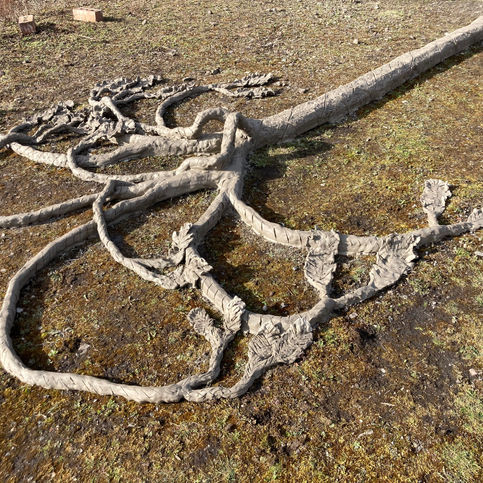In Memory of Lepidendron
“When exposed to the atmosphere, no rock (whether bedrock or man-made structures of stone) escapes the effects of weathering, the chemical alteration and mechanical breakdown of rock materials during exposure to air, moisture, and organic matter” (Skinner and Porter).
“Hope is a fertile soil where flowers blossom” (Lailah Gifty Akita)
In Memory of Lepidendron
“When exposed to the atmosphere, no rock (whether bedrock or man-made structures of stone) escapes the effects of weathering, the chemical alteration and mechanical breakdown of rock materials during exposure to air, moisture, and organic matter” (Skinner and Porter).
“Hope is a fertile soil where flowers blossom” (Lailah Gifty Akita)
Weathering Earth began 359 to 299 million years ago - the Carboniferous – a time of vast swamp forests. This sculpture is a reminder of Lepidodendron – a primitive kind of tree-like plant, related to club mosses (evergreen herbs with needle-like or scale-like leaves). Their trunks were green and could photosynthesize, unlike modern trees of today and they grew up to 30 metres tall. These ancient tree-like plants were found fossilized in Glasgow and were one species among others that eventually formed the coal mined in Scotland. Coal – an almost pure form of carbon, developed in lagoons and swamps during Carboniferous times, when forests died, decayed and became compressed into what we know as coal. The stagnant lagoons also created the perfect conditions for laying down fine sediments such as clay and silts, which became interlayered with coal.
Today the clay created during the Carboniferous has been sculpted in the memory of Lepidodendron. This sculpture is now exposed to the elements of the weather, to be weathered; worn and broken down to become soil. Because clay is mineral and has virtually little organic content, coal here is added to the sculpture, so that clay (mineral) and coal (carbon), mix together through the process of weathering to become soil. Once the weather has worked upon clay and coal, this new soil will be planted with heather to become a heather garden, forming again new life, fertile soil, organic matter, flowers for insects and enjoyment for people.
This sculpture is part of Weathering Earth – a participatory art installation and exhibition created for the Midlothian Climate Beacon developed by Nicole Manley, an environmental artist, in collaboration with the National Mining Museum Scotland and the British Geological Survey. Weathering Earth is also supported by the Edinburgh Ceramic Workshop, where Nicole Manley currently holds an art residency.




















